The 2012 MacBook Air (11 & 13-inch) Review
by Anand Lal Shimpi on July 16, 2012 12:53 PM EST- Posted in
- Apple
- Mac
- MacBook Air
- Laptops
- Notebooks
The Display
The MacBook Air is really Apple's mass-market notebook, and as such it's not going to be the target for a Retina Display upgrade, at least not this year. While technically feasible, my guess is a lack of supply kept a rMBA out of the cards for this year. There's also the matter of maintaining its thin profile and battery life in pursuit of a retina display.
The MacBook Air display continues to be good, and better than most, but no where near what the rMBP delivers and actually a step behind what the competition in the PC space has been cooking up.
If there was one clear trend at Computex this year it's towards IPS 1080p displays in Windows 8 notebooks. ASUS actually pre-empted all of the exciting announcements (rMBP included) with its Zenbook Prime, complete with 11 and 13-inch 1080p IPS displays. As the MacBook Air retains its TN display, for the first time we can actually say that ASUS' Ultrabook offers better viewing angles than the Air. The difference is quite noticeable:
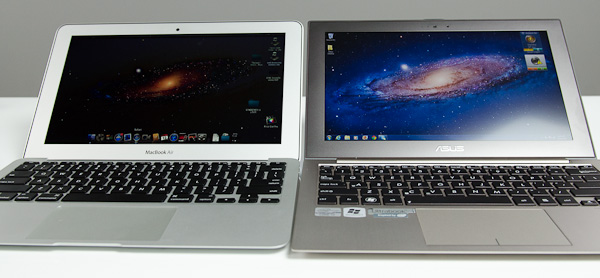
2012 MacBook Air (left) vs. 2012 ASUS Zenbook Prime (right)
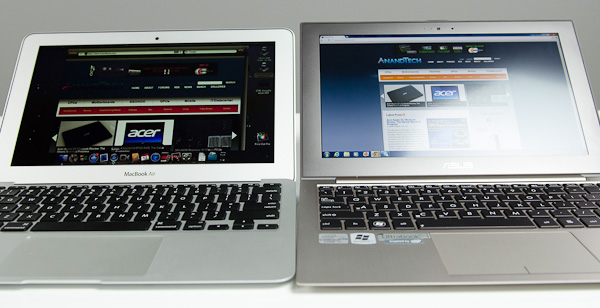
2012 MacBook Air (left) vs. 2012 ASUS Zenbook Prime (right)
ASUS also enjoys a resolution advantage, but it's not really high enough to make good use of integer DPI scaling (at 2x you get a UI sized for a 960 x 540 display). You get sharpness, and additional desktop area, but not the total package you get with the rMBP. There's no denying that what ASUS has done is better, it's just not perfect. And as Apple has shown us in the past, it's not fond of stopgap solutions.
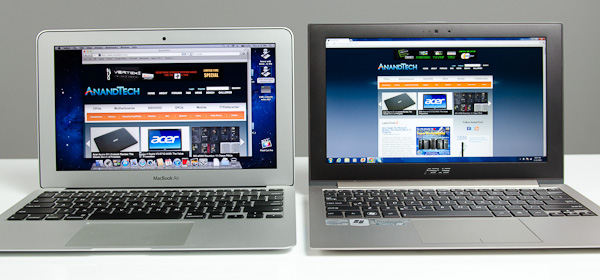
2012 MacBook Air (left) vs. 2012 ASUS Zenbook Prime (right)
Brightness, black levels, contrast, color accuracy and gamut haven't changed over the past year. The MacBook Air's panel remains one of the best non-IPS solutions on the market. The problem is that consumer insistence higher quality displays has pushed Apple's competitors to finally deliver more than TN at MacBook Air price points. Sooner rather than later, Apple will have to respond.
The Panel Lottery
Unlike in previous years, there appears to be three manufacturers supplying panels for the 2012 MacBook Air. LG Philips and Samsung return from before, but AUO now joins the fray. It's quite possible that Apple's volumes have grown large enough to justify adding a third supplier - a trend we may see increase in the future, and across more component categories.
As always, you can try to find out what panel is used in your MacBook Air by executing the following command in an OS X Terminal window:
ioreg -lw0 | grep IODisplayEDID | sed "/[^<]*</s///" | xxd -p -r | strings -6
The output will look something like this:

As long as Apple hasn't masked the data, the first line should be the part number of your display panel. The first one or two characters will tell you the manufacturer: LP for LG Philips, LT for Samsung and B for AUO. Anecdotally, LG and Samsung seem to be the most prevalent. In my personal experience with six 13-inch 2012 MacBook Airs and three 11-inch MacBook Airs, the breakdown was as follows:
13-inch $1499 - Samsung
13-inch $1499 - Samsung
13-inch $1499 - Samsung
13-inch $1499 - Samsung
13-inch $1499 - Samsung
13-inch $2199 - LG
11-inch $1099 - AUO
11-inch $1099 - AUO
11-inch $999 - Samsung
A thread over on Macrumors places the Samsung/LG split much closer to 50/50, however it's not clear if there's a higher incidence of LG panels in BTO or non-default configurations. We'd need many more samples to really get an idea for how all of this shapes up, so don't put too much faith in the results from my experience.
Apple does its best to ensure that all three panels deliver comparable performance, however there are differences. Let's first start with the numbers:
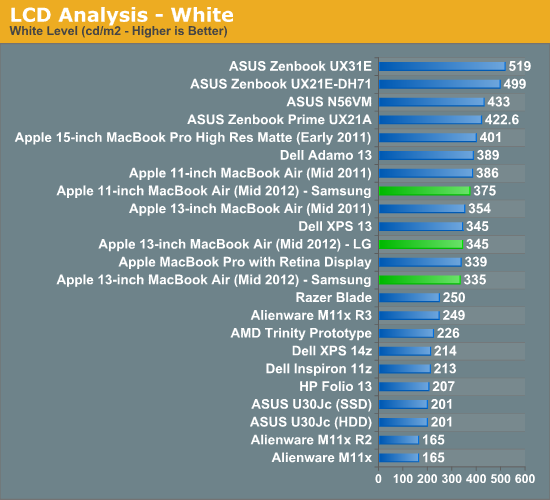
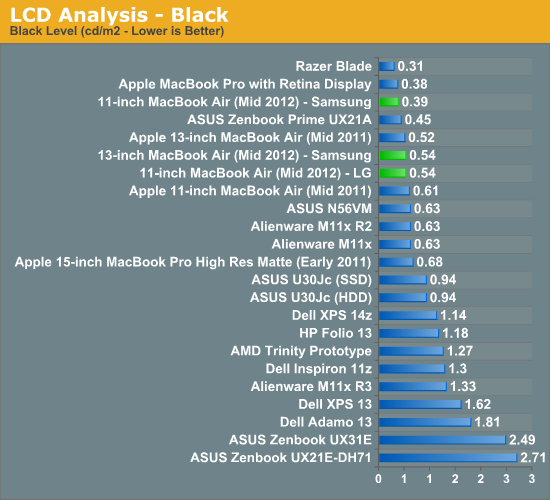
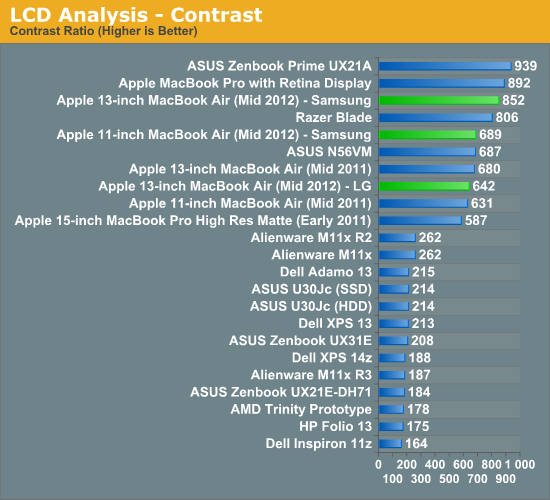
The 13-inch LG panel delivers tangibly worse black levels than the Samsung alternative. There's even a pretty dramatic difference in black levels between even the 11 and 13-inch Samsung panels. It's also possible that there's panel to panel variation at play here that would result in this sort of a difference.
The LG panel is a bit brighter, which helps it reach a decent contrast ratio but the 13-inch Samsung panel's low black levels give it an advantage. Interestingly enough, the 13-inch LG sample performed very similarly to the 11-inch Samsung. I really do wonder how much of this difference is just normal variance between panels.
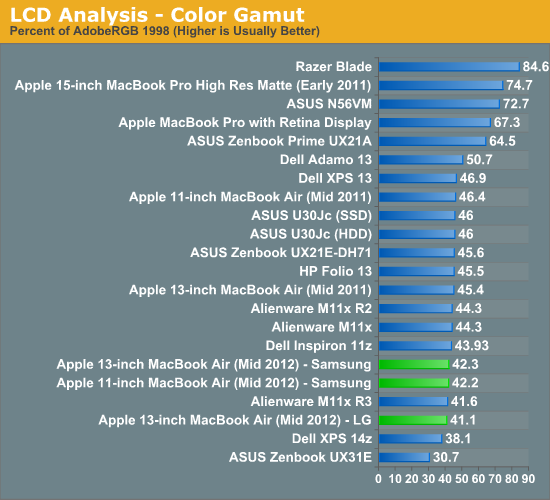
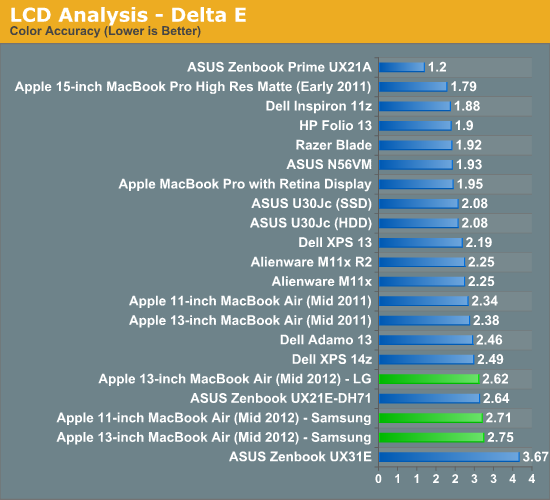
Color accuracy is slightly better on the LG panel, although it's not beyond the noticeable threshold. Color gamut is comparable between the displays.
Independently, neither the Samsung or LG panels is particularly bad to look at. These are still TN panels so you get poor vertical viewing angles, but the quality is still better than the cheaper TNs we often see used in less expensive notebooks. It's when you compare the two or you're used to one that you can really tell a difference: the Samsung panel, particularly when displaying black text on a white background, looks better than the LG.
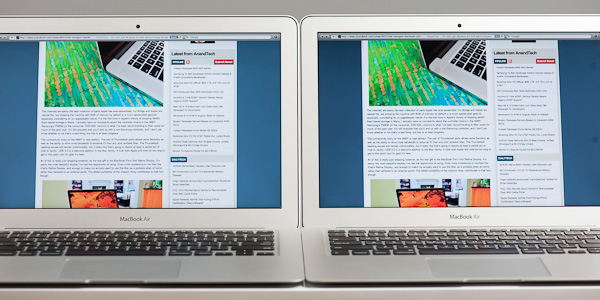
13-inch LG LP133WP1-TJA3 panel (left) vs. Samsung LTH133BT01A03 panel (right)
I had some friends over and tossed them a pair of 13-inch MBAs. One had the LG panel and one had the Samsung panel. They used the MBAs and swapped after a short while. Almost instantaneously they could tell the difference between the panels. Everyone significantly favored the Samsung.
I was actually a bit surprised how quickly they noticed the difference. With these type of things I always assume I'm just more sensitive than most, but in this case the difference was noticeable enough to pick out. Everyone added (and I agreed) that the difference was most pronounced because they were able to switch between two. In a vacuum each one seemed fine.
I tried my best to capture the difference between the two panels on camera. The easiest way to describe the difference is text on the Samsung panel just looks darker (mouse over the panel name in the table below):
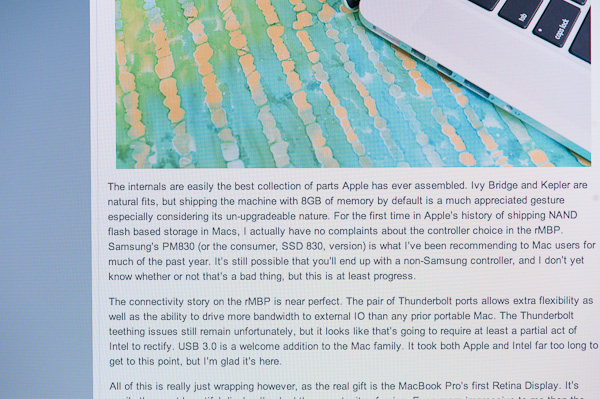
| LG LP133WP1-TJA3 | Samsung LTH133BT01A03 |
| original | original |
Just like last time, I believe the two panels behave differently in how they react to off-center viewing angles but I couldn't really capture the slight differences on camera. Although I didn't have an AUO equipped MBA on hand, the one I saw in an Apple store looked closer to the LG than the Samsung.
The good news is after a calibration pass using Color Eyes Display Pro, the difference between the two is significantly reduced - to the point where I can no longer tell the two apart:
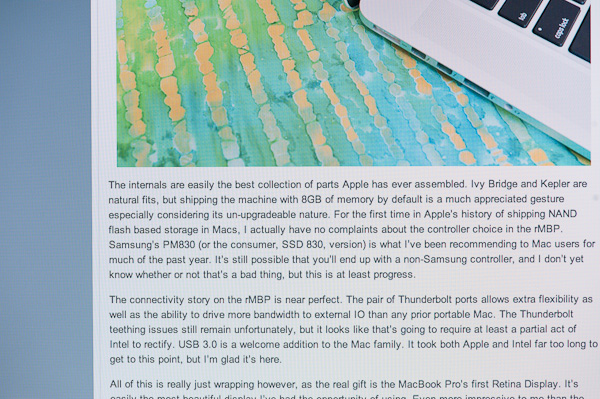
| LG LP133WP1-TJA3 | Samsung LTH133BT01A03 |
| original | original |
The obvious problem with this solution is you need access to a decent colorimeter or spectrophotometer and calibration software. There are some color profiles floating around the web that may help (I've uploaded mine for the LG here, Samsung here) but every panel is going to be at least somewhat different so this is still not perfect.
Subjectively, I'm fine with the LG panel, although I do like the look of the Samsung better. Both are a bit of a disappointment compared to what you get from the Retina Display in the MacBook Pro however. It's just presently what you give up for portability and cost.
To Make a Retina
The thing about the MacBook Air is that it's already quite minimized on the inside. The vast majority of the chassis is occupied by a battery, and there's no traditional HDD or optical drive to remove for additional space. Apple can't simply toss a much higher resolution panel on the system and call it a day, at least not without a tangible reduction in battery life.

13-inch MacBook Air (Mid 2012) - iFixit
Apple had to give the MacBook Pro with Retina Display a 95Wh battery (up from 77.5Wh) just to deliver similar battery life to the regular MacBook Pro. The higher resolution display requires a brighter backlight to push light through the panel and maintain comparable brightness levels.
The motherboard itself can stand to lose a single chip (the PCH) with the transition to Haswell, but that's not going to give us a ton of space either.
In the short term Apple could opt for a slightly thicker chassis (similar to what happened in the 3rd gen iPad) to accommodate a larger battery. Eventually the hope is that panel efficiency will increase to the point where we won't need significantly brighter backlights.


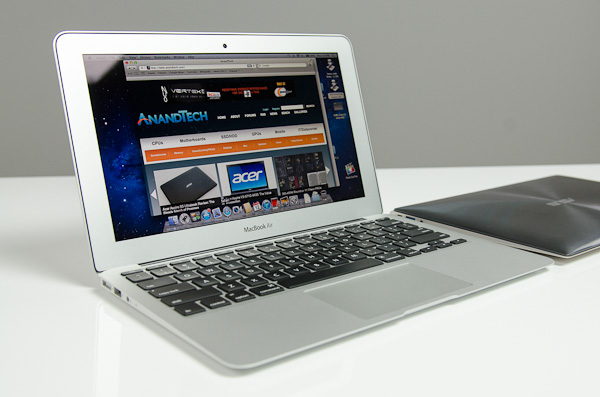








190 Comments
View All Comments
robco - Wednesday, July 18, 2012 - link
I have a few friends who upgraded to the new Airs and love them. I'm holding onto my 3 year old MBP for another year until Haswell comes out. Though it looks like the HD 4000 can keep up with or even surpass the 9600M in mine.I'm leaning toward the Air, though my personal prediction (hope?) is that when Haswell comes out next year, that will have enough oomph for Apple to launch the 13" rMBP with a 2560x1600 display. If they can keep the weight under 4 lbs., that would be awesome.
As for Apple not being the first, being first isn't always best. There were other ultraportables before the 2010 Air, but few sold in large volume. There were tablets before the iPad, but relatively few sales. There were smartphones before the iPhone, but few consumers wanted them. Being first isn't important, executing a good product is.
And for the anecdotal stories, how a company handles a problem is also quite important. I'm on my second Apple laptop, but each one has had issues (I get AppleCare). On my 2006 MB, the trim started pulling away, made an appointment at the Apple Store, they replaced the top case the same day. A week before AppleCare expired, I noticed the optical drive had failed (never really used it), they not only replaced it, but found that one of the cooling fans wasn't operating quite as fast as it should, they replaced that too. When I got my 2009 MBP, the trackpad started sticking and wouldn't click, fixed same day. I got a battery error, that was replaced in about 20 mins. No waiting on hold for hours, going through a bunch of repetitive nonsense. Fixed quickly, no questions asked. I don't expect to never have an issue, I'm hardly gentle with my laptops, but when something does happen, it's nice to know things get fixed quickly without a lot of hassle. Then again, that's just my own personal experience...
MobiusStrip - Wednesday, July 18, 2012 - link
Yay, more Apple computers with mandatory, shitty glossy screens.What kind of "leader" takes its cues from the third-tier plastic schlock being peddled at Best Buy? Glossy screens are the biggest regression in computing ever. Absolutely moronic.
Deepcover96 - Wednesday, July 18, 2012 - link
I hadn't noticed that my 2012 MacBook Air's screen was glossy. Maybe they made it less glossy?phillyry - Tuesday, March 26, 2013 - link
Maybe they made them extra glossy on purpose so that we wouldn't be able to notice the terrible viewing angles for all the glare!phillyry - Thursday, March 28, 2013 - link
Also helps to hide the pixelation.Lepton87 - Wednesday, July 18, 2012 - link
I have something to say regarding anand's conclusion that 1920x1200 on a 11' is a stopgap solution and apple is too great to settle for something so mediocre. 2732x1536 on the 11.6 is totally idiotic. You don't need more than 120PPI on a desktop and 140PPI on a laptop for a screen to be considered retina.(remember viewing distance is a big factor) So why waste all that processing power? Even retina Macbook pro can't render everything silky smooth. Even my 2560x1440 desktop 27'' "lowly" resolution screen is 90% retina, taking into account my less than perfect eyesight into equation it's probably very close all that I need to not seen individual pixels from normal viewing distance. 2880x1800 on 27' would make it a perfect screen for my, everthing more than that would choke my already outdated quadfire 2x6990 CF set-up. The boss probably won't honor me with answering this personally :( I would really like to know his view on increasing resolution way past what would be considered retina, i.e making pixels much smaller than the necessary size for them to be not discernible individually from normal viewing distance.Znarkus - Thursday, July 19, 2012 - link
It would've been awesome to compare max power draw and surface temperature with the different CPUs, especially the i7 :)Alameda - Saturday, July 21, 2012 - link
I have a 2011 MacBook Air. I think the big improvement in 2012 is USB 3. Time Machine backups take a very long time (I backup once every few days). USB 3 would clearly make a big difference here. Thunderbolt, sadly, is too expensive to justify, unless you're backing up to a RAID or some such.Galatian - Sunday, July 22, 2012 - link
Hey Anand,I have yet to get back to you again concerning the Gaming Performance on the i5 ULV with HD4000. I was coming from a 2008 Unibody MacBook Pro (2,53 GHz, 8 GB RAM, Vertex 2, nVidia 9600M 512 MB vRAM), so I naturally expected that Civilization V would not run as fast on my new MacBook Air under Windows than it did on my old MacBook Pro. At least your charts suggest so. According to FRAPS I would get around 22 fps, which is not stellar but enough for turn based strategy game.
I don't know if there has been any update on the driver or what, but Civilization V is actually more playable on my MacBook Air then on my old MacBook Pro. The CPU of course is faster. My MacBook Pro would overheat and hence the Core 2 Duo only ran with like 2,0 GHz while playing the game, while the Ivy Bridge ULV actually still has enough headroom to Turbo Boost. The big surprise to me was actually the graphic performance, which has been much smoother. For the sake of it I would really like to know how you get your extremely low fps while testing Civilization V? Are you running the newest version w/o Gods & Kings add-on? Do other persons have the same experience? I thought I would make a step back in gaming performance when I switched to the MacBook Air, but to my surprise this isn't the case. I sure would like other people to know this, so they can put the Ivy Bridge ULV in better perspective.
Along the line I would really like to see a comparison between AMDs and Intels ULV offerings. The tests I see only only compare the A10 (which has a much higher TDP) to Intels ULV platform. From my understanding only the Bobcat should be comparable to Intels ULV offering. Then again I really can't follow what is what with AMD especially I don't which ones are released and which ones are not...
cookiezulu - Monday, July 30, 2012 - link
Hi Anand, thank you for yet another excellent review! I was worried for a sec there that you might be busy with other things and skip the review for the MBA this year.The MBA 2012 (8GB, stock processor) is my first ever MAC and also my first computer with an SSD drive. I'm not very familiar with how the SD Card slots work in these SSD machines and/or in Mac machines and I would like to buy one of these:
http://www.kickstarter.com/projects/1342319572/the...
It's essential a microSD card holder that sits flush with the MBA (rather than sticking out). I held out because of the issue of the SD card preventing the computer from going into deep sleep mode, as per Apple support article here:
https://support.apple.com/kb/HT4392
Somebody then thought to ask what happens if the SD/microSD card is left in place but it is unmounted on a software level. In theory this should allow the Macs to go into deep sleep (standby) mode as the SD card slot would be just as 'dead' as if the card wasn't there.
I'm definitely looking to always have an SD card into the slot, both to increase storage but also, and more importantly, to use it for exactly the types of activities that you mention in the article as slowing it down. I want the SSD to run just operating system and installed programs. All others (downloads, music, photo, etc) I want to keep on external devices.
Can you, by any chance, offer any help/info/clarification on this one?
Thanks ever so much